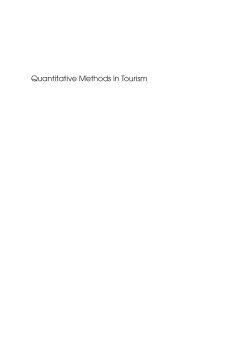
Additional Information
Book Details
Abstract
Tourism studies often deal with complex mixes of external and local factors and the attitudes, perceptions and actions of tourists themselves. In seeking to understand individual elements of this mix, or the results of interactions between them, tourism authorities, managers and researchers often collect quantitative data, but until now the few existing guides to understanding quantitative data have been either very simple or very complicated. This book provides a guide to dealing with real-world data and goes beyond the methods usually covered in introductory textbooks. The first part considers key issues associated with using well known methods to produce valid and reliable models of real-world phenomena, emphasizing issues in data selection, approaches to factor and cluster analysis, and mathematical modelling using regression methods (including logistic regression) and structural equation modelling. The second part covers new approaches to modelling: maximum likelihood estimation, simulation and agent-based modelling. Each chapter includes extensive references to additional reading, and an appendix summarises the software introduced in the book. The book provides many practical examples of applications to tourism research, considers practical issues associated with application of quantitative techniques, and discusses common pitfalls and how to identify and remedy them. The result is a guide to quantitative methods in tourism that de-mystifies both simple and apparently complex techniques and makes them more accessible to tourism researchers.
This is a book that is urgently needed and fills a gap in tourism. Quantitative Methods in Tourism is well crafted and unique in its coverage and scope. The book takes you from data generation to hypothesis testing, data analysis, model building to multivariate statistics, forecasting and simulation. It is an excellent addition to the scholarly tourism literature. It is a must have book for anyone who is involved in tourism analysis and research.
Rodolfo Baggio holds a degree in Physics (MPhys) and a PhD in Tourism Management. After having worked for leading information technology firms for over 20 years he is presently at the Bocconi University, Milan, Italy, where he teaches courses in Computer Science and coordinates the Information and Communication Technologies area at the Master in Economics and Tourism. He is also Research Fellow at the Carlo F. Dondena Centre for Research on Social Dynamics. He has managed several international research projects and actively researches and publishes in the field of information technology and tourism. His current interests focus on the application of complexity theory and network analysis methods to the study of tourism destinations.
Jane Klobas is Alberto Dondena Research Fellow at the Carlo Dondena Centre for Research on Social Dynamics at Bocconi University in Milan, Italy, and Professor at the University of Western Australia Business School. She teaches quantitative research methods to undergraduate, master and doctoral degree students in Italy and Australasia, and conducts applied research using both qualitative and quantitative research methods. She is author or co-author of several books and book chapters, and has published research on the psychology and management of technology-mediated learning and knowledge sharing in many journals.
Unlike other books on this subject, Quantitative Methods in Tourism does not focus on theoretical discussion on presented techniques. It is therefore quite practical and could be successfully used either as a textbook (as an overview of different statistical methods) or as a reference (for more detailed explanation of a particular technique). It could definitely improve the quality and reliability of any research or at least give some inspirational insights on plethora of methods in statistic that could be applied in tourism analysis.
The authors have produced an informative, interesting and timely book on quantitative methods for tourism. The book is well written and provides examples throughout thus making the challenging content very accessible. Software programs are also highlighted to assist researchers in choosing the right tools for the job. This book is a must read for both researchers and research students, especially those who want an understanding of emerging techniques to advance the tourism field.
The book provides thoughtful, insightful introduction into the logic of many well-known statistical methods used in tourism and some that are not as well known but have significant potential for tourism...Quantitative Methods in Tourism presents fresh and timely information on many of the more important – and some less familiar – techniques useful in tourism research. The book is logically organized and written in an easy, approachable, lucid style.
Stephen L. J. Smith, University of Waterloo, Canada in Tourism Recreation Research Vol. 36, No. 3, 2011
It presents a quite interesting and exciting perspective regarding research methods in tourism. I would encourage tourism scholars and practitioners to pick up a copy as it will help them better understand and appreciate how to address the many challenges facing tourism research.
Dr. Daniel R. Fesenmaier, Director, National Laboratory for Tourism & eCommerce, School of Tourism and Hospitality Management, Temple University
Table of Contents
| Section Title | Page | Action | Price |
|---|---|---|---|
| Contents | v | ||
| List of Examples | vii | ||
| List of Figures | ix | ||
| List of Tables | xv | ||
| Contributors | xvii | ||
| Foreword | xix | ||
| Introduction | xxi | ||
| Part 1 The Analysis of Data | 1 | ||
| Introduction to Part 1 | 3 | ||
| Chapter 1\rThe Nature of Data in Tourism | 5 | ||
| Chapter 2\rTesting Hypotheses | 21 | ||
| Chapter 3\rData Analysis | 42 | ||
| Chapter 4\rModel Building | 88 | ||
| Chapter 5\rTime-dependent Phenomena and Forecasting | 136 | ||
| Part 2 Numerical Methods | 171 | ||
| Introduction to Part 2 | 173 | ||
| Chapter 6\rMaximum Likelihood Estimation | 175 | ||
| Chapter 7\rMonte Carlo Methods | 189 | ||
| Chapter 8\rAgent-based Modeling and Simulations | 199 | ||
| Appendix: Software Programs | 220 |
